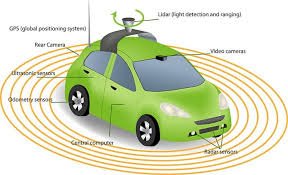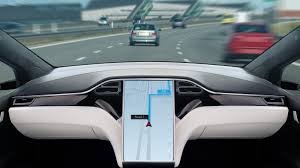Self-Driving-Cars:Future of Autonomous Mobility
Use of artificial intelligence particularly AI and sensors and more complex algorithms in an endeavor to determine the right course, understand traffic signs & light and make decisions on its own. From reducing the risks of road accidents to minimizing traffic jam and emissions self-driving cars come with several advantages. But the use of such vehicles also entails technical, ethical and regulatory issues that have to be resolved for them to become reality as currently being seen.


The Technology Behind Self-Driving Cars:
1. Sensors and Hardware
In addition to the aforementioned key sensors, self driving cars include LiDAR (Light Detection and Ranging), Radar, cameras and ultrasonic sensors. The reason behind this is because laser beam relevant LiDAR mapping the surroundings, while radar uses electromagnetic waves to determine the speed and distance of all the objects in the environment. Cameras offer sensory input about the lanes, traffic lights, and obstacles as the vehicle goes around. They come in close range applications and include such features as the parking aid system. These sensors help in the capturing of data of the environment surrounding the vehicle in real time and feeding the system with relevant data.

2. Artificial Intelligence and Machine learning Grant 2
AI and ML form the core of the self-driving vehicles operation. The sensing data is managed and interpreted by the onboard car computer through artificial intelligence being used to decide on the car path. It is possible for the efficiency of the system’s driving to enhance their performance over time because machine learning applies data or experience. AI helps self-driving cars to identify objects, understand the actions of other drivers and react to road processes in real time.
3. GPS and Navigation Systems
Machine vision that enables identification of its environment and processing of essential cues for self-driving cars including GPS and high-definition maps. These maps have information regarding the actual structure of the roads including intersection points, traffic flow and sometimes even altitude difference. Combined with real-time global positioning system information, self-driving cars are well placed to identify themselves and the most optimal paths to take to the intended location. Sometimes these maps are updated constantly through a cloud based system that lets the car know that there may be a change in the roads’ conditions or construction zones, etc.

Levels of Autonomy :
Level 0 (No Automation): All driving tasks are thereby allocated to the driver. Level 1 (Driver Assistance): The vehicle can help with either steering or acceleration, but the driver controls. Level 2 (Partial Automation): Steering and acceleration are both under the vehicle’s control, but at any moment the driver is responsible for taking over. Level 3 (Conditional Automation): It’s got automation, but the driver needs to be on hand to let it continue if the car decides it needs to take control for safety reasons. Level 4 (High Automation): In certain conditions, it takes all the driving decisions for the vehicle. But sometimes, a driver will still be necessary. Level 5 (Full Automation): It’s a totally autonomous car, which is capable of driving in any conditions without any human intervention. Even though most of the self driving cars roaming the streets today are Level 2 or Level 3 (or above), cars being worked on by brands like Tesla, Waymo, and General Motors are being developed for Level 4 and Level 5 autonomy.
Advantages of Self-Driving Cars :
Level 0 (No Automation): All driving tasks are thereby allocated to the driver. Level 1 (Driver Assistance): The vehicle can help with either steering or acceleration, but the driver controls.
Level 2 (Partial Automation): The vehicle is in control of steering and acceleration, but at any time the driver is in control.
Level 3 (Conditional Automation): There’s automation, but the driver has to do their bit before letting it carry on should the car determine it must take control for safety reasons.
Level 4 (High Automation): It makes all the decision for the vehicle to drive in some conditions. Though sometimes a driver will still be needed.
Level 5 (Full Automation): It’s a totally autonomous car, that’s able to drive in any conditions, and doesn’t need any human intervention. Although all of the ‘self driving’ cars out there on roads today, even 2 or 3, cars being worked on today at Tesla, Waymo and General Motors, are being designed for Level 4 and 5 autonomy (the Baidu Whoosh); they even have spoken about it.
Enhanced Road Safety
The other singular greatest benefit of self driving cars is without doubt possibility to remove numbers of traffic accidents made by people who mess up, as the World Health Organization (WHO) is for instance saying that more than 1. In road traffic crashes, around three million people lose their lives each year and most of these deaths are tragic consequences of bad decisions our drivers make. The self-driving vehicles will be free from distractions, fatigue, and for instance alcohol hence greatly reducing the incidents of accidents.
2. Increased Mobility for All
They provide more opportunities for those persons who cannot drive the car because of age, disability or something else. For elderly people and for those people who have a vision or physical disability, experiencing can lead to enhanced level of mobility and overall well-being. Self-driving cars or ride sharing transport may actually enable more people to have better access and or affordable means of transport.
3. The Other Effectiveness Of This Travel Plan Is That It Will Result In Less Traffic Density And Pollution.
Self-driving cars are expected to be able to exchange information with other cars and manage the traffic flow in the roads in an efficient manner thus eliminating traffic congestion. They can also save fuel and gases by driving more efficiently; maintaining proper speed, avoiding section changes and following the speed limit and other luxury such as avoiding hard breaking or frequent gear changing and unnecessary time in idle. Fleets of electric self-driving cars can potentially lead to improvement of the quality of the urban environment in the long run.
4. Increased Productivity and Comfort
If vehicles have advanced enough as to become fully autonomous, people on board would be able to perform other work. Passengers could exercise, read or just watch a movie while the vehicle is on the move and will drive itself. Also, self-driving cars could include superior entertainment, conditioning and setting options, as well as varying driving environments for human passengers.
Challenges and Concerns:
1. Technical and Safety Issues
However, there are still many technical issues found in the self-driving cars regardless of the developments made on this technology. Common implications include, where the sensors will fail to perform well during extreme weather conditions such as; rainfall, snow, fog and might provide inaccurate results. Also, self-driving cars have to recognize various worrisome and challenging actions of other individuals, for example, people crossing the road outside of crosswalks or cyclists suddenly avoiding obstacles.
2. Ethical Dilemmas
Some ethical issues that arise with self-driving cars are; Moral Dilemma: Moral questions arise, especially when the decision is life or several others lives, when self driving cars are to make the decisions. Imagine for example, a self driving car which has no choice but to crash, which one would it pick to save, the passengers or the people walking. These moral dilemmas pose great difficulty for the developers and policymakers since the question is raised of how such cars are going to handle such situations.
3. Regulatory & Legal Issues
It is for this reason that both the national and supranational authorities and self-regulatory organization have to establish the conditions that would provide safety while not inhibiting the development of new technologies. Additionally, we can expect the degree to which consumer acceptance of self driving cars can be in deciding the success of self driving cars; also there are other important issues related with loss of the jobs that may take place in the case of them replacing the tasks performed by particular professions like a long distance lorry driver or taxi driver.
Future of Self-Driving Cars:
Including artificial intelligence, machine learning and the sensors used in the cars are consistently proving that self-driving cars are feasible and can be developed further. Virtual/AI enabled automobiles are presently being developed by top auto as well as tech players, with a good number of auto industry experts expecting that cars with Level-5 autonomy may soon be on the roads mainly within the next decade.
In the context of personal transportation the primary impact of self-driving cars is rather obvious, yet there are several industries that will be affected greatly: logistics and public transportation for example. Self-driving cars deliveries, trucks and buses can bring a radical shift in supply chain including in urban settings and from cost and environmental perspectives.

Conclusion
Automobiles that can operate themselves are the future of transport systems; they have many advantages in relation to safety, mobility and productivity. In the furture, the self driving car is going to become even more important in how we commute, how we earn our livelihood and how we exist as humans. Nevertheless, the way to embarked on the mass use of RPA will involve overcoming several technical, ethical, and regulatory hurdles. Thanks to research and development of new technologies along with the integration of expertise with the application of new concepts, self driving cars are at a promising stage where they can revolutionize the transport system.








2 thoughts on “Self-Driving Cars: The Future of Autonomous Mobility”